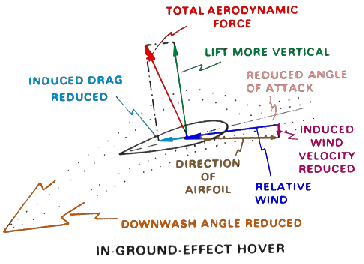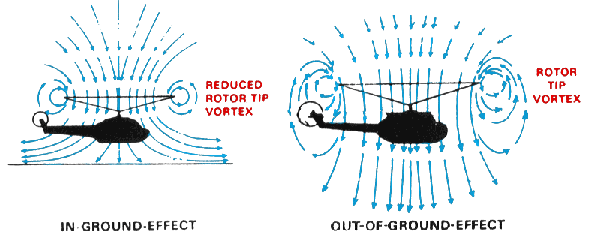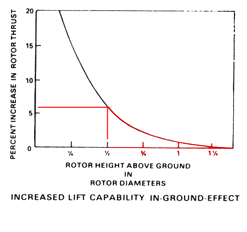

Ground Effect is a condition of improved performance encountered when operating near (within 1/2 rotor diameter) of the ground. It is due to the interference of the surface with the airflow pattern of the rotor system, and it is more pronounced the nearer the ground is approached. Increased blade efficiency while operating in ground effect is due to two separate and distinct phenomena. The high power requirement needed to hover out of ground effect is reduced when operating in ground effect.
First and most important is the reduction of the velocity of the induced airflow. Since the ground interrupts the airflow under the helicopter, the entire flow is altered. This reduces downward velocity of the induced flow. The result is less induced drag and a more vertical lift vector. The lift needed to sustain a hover can be produced with a reduced angle of attack and less power because of the more vertical lift vector:

The second phenomena is a reduction of the Rotor Tip Vortex:

When operating in ground effect, the downward and outward airflow pattern tends to restrict vortex generation. This makes the outboard portion of the rotor blade more efficient and reduces overall system turbulence caused by ingestion and recirculation of the vortex swirls.
Rotor efficiency is increased by ground effect up to a height of about one rotor diameter for most helicopters.This graphic displays the percent increase in rotor thrust experienced at various rotor heights:
|

|
Maximum ground effect is accomplished when hovering over smooth paved surfaces. While hovering over tall grass, rough terrain, revetments, or water, ground effect may be seriously reduced. This phenomena is due to the partial breakdown and cancellation of ground effect and the return of large vortex patterns with increased downwash angles.
Two identical airfoils with equal blade pitch angles are compared graphically:
|

|
 Return to Dynamic Aerodynamics!
Return to Dynamic Aerodynamics!
 Return to Dynamic Flight
Return to Dynamic Flight
Copyright ©1999-2017 Dynamic Flight, Inc. All rights reserved.
Page Last Updated on: Nov-06-2017